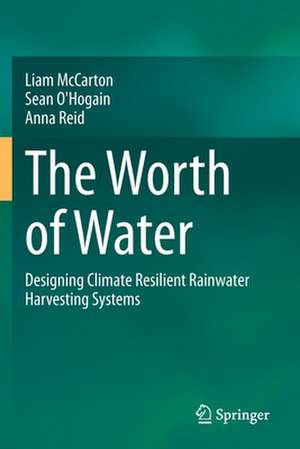The Worth of Water: Designing Climate Resilient Rainwater Harvesting Systems
Autor Liam McCarton, Sean O'Hogain, Anna Reiden Limba Engleză Paperback – 11 noi 2021
| Toate formatele și edițiile | Preț | Express |
|---|---|---|
| Paperback (1) | 524.36 lei 6-8 săpt. | |
| Springer International Publishing – 11 noi 2021 | 524.36 lei 6-8 săpt. | |
| Hardback (1) | 729.68 lei 6-8 săpt. | |
| Springer International Publishing – 10 noi 2020 | 729.68 lei 6-8 săpt. |
Preț: 524.36 lei
Preț vechi: 616.90 lei
-15% Nou
Puncte Express: 787
Preț estimativ în valută:
100.35€ • 103.67$ • 83.52£
100.35€ • 103.67$ • 83.52£
Carte tipărită la comandă
Livrare economică 26 martie-09 aprilie
Preluare comenzi: 021 569.72.76
Specificații
ISBN-13: 9783030506070
ISBN-10: 303050607X
Pagini: 206
Ilustrații: XXIV, 206 p. 199 illus., 193 illus. in color.
Dimensiuni: 155 x 235 mm
Greutate: 0.33 kg
Ediția:1st ed. 2021
Editura: Springer International Publishing
Colecția Springer
Locul publicării:Cham, Switzerland
ISBN-10: 303050607X
Pagini: 206
Ilustrații: XXIV, 206 p. 199 illus., 193 illus. in color.
Dimensiuni: 155 x 235 mm
Greutate: 0.33 kg
Ediția:1st ed. 2021
Editura: Springer International Publishing
Colecția Springer
Locul publicării:Cham, Switzerland
Cuprins
Chapter1: The circular economy of water (CEW).- Chapter2: Water treatment: pollution removal mechanisms in the rainwater harvesting process.- Chapter3: Supply & demand: multiple waters for multiple purposes and multiple uses.- Chapter4: The components of a rainwater harvesting system: modular, standardised, plug and play.- Chapter5: Climate resilient RWH: a technological portfolio.- Chapter6: Rainwater harvesting design.- Chapter7: The economics of rainwater harvesting.- Chapter8: Rainwater harvesting and the sustainable development goals (SDG's).
Notă biografică
Dr. Liam McCarton is a lecturer in the School of Civil & Structural Engineering at Technological University Dublin. He is Director of Engineers Without Borders, Ireland. He is experienced with over twenty five years of lecturing, international development program management, environmental engineering design and commissioning of water and sanitation, and education and health infrastructure projects.
Dr. Sean O’Hogain is a lecturer in the School of Civil & Structural Engineering at Technological University Dublin, specialising in water and wastewater analysis. His research topics have included Reed beds, Rainwater Harvesting and International Development, and he has conducted research projects in Ireland, Latin America and Africa.
Anna Reid is a Senior Technical Officer in the School of Civil & Structural Engineering at Technological University Dublin. She is in charge of the supervision, coordination, direction and administration of assigned Technicians and Technical Officers, and is currently pursuing research in sustainable water supply/rainwater harvesting.
Dr. Sean O’Hogain is a lecturer in the School of Civil & Structural Engineering at Technological University Dublin, specialising in water and wastewater analysis. His research topics have included Reed beds, Rainwater Harvesting and International Development, and he has conducted research projects in Ireland, Latin America and Africa.
Anna Reid is a Senior Technical Officer in the School of Civil & Structural Engineering at Technological University Dublin. She is in charge of the supervision, coordination, direction and administration of assigned Technicians and Technical Officers, and is currently pursuing research in sustainable water supply/rainwater harvesting.
Textul de pe ultima copertă
There is no more fundamental substance to life on earth than water. Ninety nine percent of all human molecules are water molecules. Three quarter of the earth’s surface is covered by either saltwater or freshwater, yet millions face a daily struggle to access enough water for survival. The effects of ongoing climate change have expanded the water crisis to areas previously considered water secure. This book addresses the role rainwater harvesting (rwh) can play in developing a resilient water infrastructure that will prove adaptive to climate change and its implications. The book features three sections. The first section presents the concepts underpinning a new approach to water infrastructure. The term “the worth of water” was developed to reflect the importance of the social life of water. This encompasses all human relationships with water including the social, cultural, hydrological, political, economic, technical and spiritual. A technology portfolio showcasing the worth of waterfrom the qanats of the ancient world to the modern rain cities is presented. Other concepts discussed include the circular economy of water and the concept of multiple waters for multiple users of multiple qualities. Water and its properties are a function of its peculiar molecular structure and this is illustrated in the book. Rainwater harvesting is considered by the authors as containing an inherent treatment train which functions as a complex water treatment system. The physical, chemical and biological removal mechanisms that form an inherent part of the rwh system are discussed. Part two presents a new rwh design methodology together with design templates and worked examples for the hydraulic and economic analysis of rwh systems. A state-of-the-art literature review of the potential health implications of utilizing rwh is also presented. The final section of the book discusses how rwh can play a vital role in contributing to achieving the sustainable development goals and to living within the planetary boundaries.
Caracteristici
Offers research on the design of rainwater harvesting (rwh) systems, water quality and quantity monitoring, and the economics of rwh systems Presents the concept of multiple waters for multiple purposes and users Aimed at both high income and low income countries by addressing the role of rwh in attaining the Sustainable Development Goals (SDG's)
